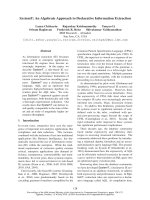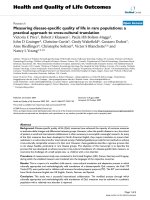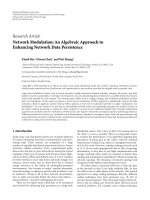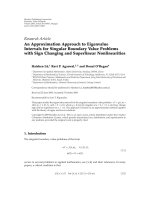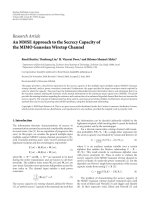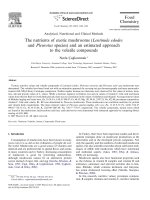An Ecosystem Approach to Developing Infrastructure Projects potx
Bạn đang xem bản rút gọn của tài liệu. Xem và tải ngay bản đầy đủ của tài liệu tại đây (2.27 MB, 99 trang )
Eco-Logical
An Ecosystem Approach
to Developing
Infrastructure Projects
Notice
This document is disseminated under the sponsorship of the Department of
Transportation in the interest of information exchange. The United States
Government assumes no liability for its contents or use thereof.
REPORT DOCUMENTATION PAGE
Form Approved
OMB No. 0704-0188
P
ublic reporting burden for this collection of information is estimated to average 1 hour per response, including the time for reviewing instructions, searching existing data
s
ources, gathering and maintaining the data needed, and completing and reviewing the collection of information. Send comments regarding this burden estimate or any
o
ther aspect of this collection of information, including suggestions for reducing this burden, to Washington Headquarters Services, Directorate for Information Operations
and Reports, 1215 Jefferson Davis Highway, Suite 1204, Arlington, VA 22202-4302, and to the Office of Management and Budget, Paperwork Reduction Project
(0704-0188), Washington, DC 20503.
1. AGENCY USE ONLY (Leave blank)
2
. REPORT DATE
April 2006
3
. REPORT TYPE AND DATES COVERED
Final Report
October 2002 – April 2006
4. TITLE AND SUBTITLE
Eco-logical: An Ecosystem Approach to Developing Infrastructure Projects
5
. FUNDING NUMBERS
CK06300/HW1P00
6. AUTHOR(S)
Janice W. Brown
7. PERFORMING ORGANIZATION NAME(S) AND ADDRESS(ES)
U.S. Department of Transportation
Research and Innovative Technology Administration
Volpe National Transportation Systems Center
55 Broadway, Kendall Square
Cambridge, MA 02142-1093
9
. SPONSORING/MONITORING AGENCY NAME(S) AND ADDRESS(ES)
Office of Project Development and Environmental Review
Federal Highway Administration
U.S. Department of Transportation
400 7th Street, SW
Washington, DC 20590
11. SUPPLEMENTARY NOTES)
This document is available to the public through the National Technical Information Service, Springfield, Virginia 22161.
8. PERFORMING ORGANIZATION
REPOR
T NUMBER
DOT-VNTSC-FHWA-06-01
10. SPONSORING/MONITORING
AGENCY REPORT
NUMBER
FHWA-HEP-06-011
12a. DISTRIBUTION/AVAILABILITY STATEMENT
This document is available to the public through the National Technical Information
Service, Springfield, Virginia 22161.
12b. DISTRIBUTION CODE
13. ABSTRACT (Maximum 200 words)
Sometimes the development of infrastructure can negatively impact habitat and ecosystems. Ways to better avoid,
minimize, and mitigate these impacts, as well as the impacts of past infrastructure projects, have been developed.
Nevertheless, these avoidance, minimization, and mitigation efforts may not always provide the greatest environmental
benefit, or may do very little to promote ecosystem sustainability. This concern, along with a 1995 Memorandum of
Understanding to foster an ecosystem approach and the Enlibra Principles, brought together an interagency team to
collaborate on writing
Eco-Logical: An Ecosystem Approach to Developing Infrastructure Projects.
Eco-Logical is guide to making infrastructure more sensitive to wildlife and ecosystems through greater interagency
cooperative conservation. It describes ways for streamlining the processes that advance approvals for infrastructure
projects – in compliance with applicable laws – while maintaining safety, environmental health, and effective public
involvement. As a way to accomplish this, the guide outlines an approach for the comprehensive management of land,
water, and biotic and abiotic resources that equitably promotes conservation and sustainable use. Key components of the
approach include integrated planning, the exploration of a variety of mitigation options, and performance measurement.
15. NUMBER OF PAGES
96
16. PRICE CODE
20. LIMIT
A
TION OF ABSTRACT
14. SUBJECT TERMS
Environment, ecosystem approach, integrated planning, infrastructure, wildlife, habitat,
Regional Ecosystem Framework, mitigation, ecosystem-based mitigation, per
for
mance
measurement, connectivity, predictability, conservation, transparency
17. SECURITY CLASSIFICATION
OF REPORT
Unclassified
18. SECURITY CLASSIFICATION
OF THIS P
AGE
Unclassified
19. SECURITY CLASSIFICATION
OF ABSTRACT
Unclassified
NSN 7540-01-280-5500
Standard For
m 298 (Rev
. 2-89)
Prescribed by ANSI Std. 239-18
298-102
The authors of Eco-Logical spent nearly three years developing this document. The Steering Team for
this effort is comprised of representatives from the Bureau of Land Management (BLM), U.S.
Environmental Protection Agency (EPA), Federal Highway Administration (FHWA), National
Oceanic and Atmospheric Administration Fisheries Service (NOAA Fisheries Service), National Park
Service (NPS), U.S. Army Corps of Engineers (USACE), U.S. Department of Agriculture Forest
Service (USDA FS), U.S. Fish and Wildlife Service (USFWS), the Volpe National Transportation
Systems Center, the Knik Arm Bridge and Toll Authority, and several State Departments of
Transportation (DOT), including North Carolina DOT, Vermont Agency of Transportation, and
Washington DOT, contributed to the completion of
Eco-Logical.
Steering Team
Carol Adkins, Federal Highway Administration
Cassandra Allwell, Volpe National Transportation Systems Center
Rosana Barkawi, Forest Service
Janice Brown, Federal Highway Administration
Jeff Bryan, Volpe National Transportation Systems Center
Rich Bulavinetz, Bureau of Land Management
Joe Burns, Fish and Wildlife Service
Ann Campbell, Environmental Protection Agency
Madelyn Carpenter, National Park Service
Dave Cavanaugh, Bureau of Land Management
John Dennis, National Park Service
Dennis Durbin, Federal Highway Administration
Paul Garrett, Federal Highway Administration
James Gavin, Environmental Protection Agency
Bill Gilmore, North Carolina Department of Transportation
Jake Hoogland,
National Park Service
Palmer Hough, Environmental Protection Agency
Gary Jo
hnston,
N
ational P
ark Service
Alex Levy, Federal Highway Administration
Kimber
l
y Majer
us, Federal Highway Administration
Jennif
er Moy
er, Army Corps of Engineers
Mike Murphy, Forest Service
Dale Paulson, Knik Arm Bridge and Toll Authority
Tom Pettigrew, Forest Service
Carson Poe, Volpe National Transportation Systems Center
Nan Reck, National Oceanic and Atmospheric Administration Fisheries Service
Morgan Rober
tso
n, Enviro
nmental Protection Agency
Bill Ruediger, Forest Service
Shari Schaftlein, Federal Highway Administration
Dave Scott, Vermont Agency of Transportation
Elaine Suriano, Environmental Protection Agency
Paul Wagner, Washington State Department of Transportation
Acknowledgments
_________________________________
Dale Bosworth, Chief of Forest Service
Forest Service
U.S. Department of Agriculture
_________________________________
J. Richard Capka, Acting Administrator
Federal Highway Administration
U.S. Department of Transportation
_________________________________
Kathleen Clarke, Director
Bureau of Land Management
U.S. Department of the Interior
_________________________________
George S. Dunlop, Principal Deputy
Assistant Secretary
Department of the Ar
my
_________________________________
H. Dale Hall, Director
U.S. Fish and Wildlife Service
U
.S
.
Depar
tment of the Inter
ior
_________________________________
Fran Mainella, Director
National Park Service
U.S. Department of the Interior
_________________________________
Anne Miller, Director
Office of Federal Activities
U.S. Environmental Protection Agency
_________________________________
Diane Regas, Director
Office of Wetlands, Oceans, and Watersheds
U.S. Environmental Protection Agency
_________________________________
James R. Walpole, General Counsel
National Marine Fisheries Service
National Oceanic and Atmospheric Administration
Benefits for the Steering Team Partners
BLM: Improved resource conservation during land use plan development
EPA: Greater flexibility to do environmental good
FHWA: Streamlined project development and improved mitigation opportunities
NOAA Fisheries Service: Early application of science for solutions
NPS: Using science to protect natural resources while providing visitor experience
USACE: Finding the balance to keep waters clean and clear
USDA FS: Stewardship of natural resources and facilitated use of public lands
USFWS: One conser
vation framework, endless possibilities for par
tnership
Eco-Logical: An Ecosystem Approach
to Developing Infrastructure Projects
Prepared by the Steering Team
April 2006
Signed by the Steering Team Partners’ Leadership
BLM . . . . . . . . . . . . . . . .Bureau of Land Management
CAPS . . . . . . . . . . . . . . . .Conservation Assessment and Prioritization System
CEQ . . . . . . . . . . . . . . . .Council on Environmental Quality
CFR . . . . . . . . . . . . . . . .Code of Federal Regulations
CWA . . . . . . . . . . . . . . . .Clean Water Act
DOI . . . . . . . . . . . . . . . .Department of the Interior
DOT . . . . . . . . . . . . . . . .Department of Transportation
EEP . . . . . . . . . . . . . . . .Ecosystem Enhancement Program
EO . . . . . . . . . . . . . . . .Executive Order
EPA . . . . . . . . . . . . . . . .Environmental Protection Agency
ESA . . . . . . . . . . . . . . . .Endangered Species Act
FHWA . . . . . . . . . . . . . . . .Federal Highway Administration
FTA . . . . . . . . . . . . . . . .Federal Transit Administration
GAO . . . . . . . . . . . . . . . .Government Accountability Office
GARVEE . . . . . . . . . . . . . . . .Grant Anticipation Revenue Vehicles
GIS . . . . . . . . . . . . . . . .Geographic Information Systems
HCP . . . . . . . . . . . . . . . .Habitat Conservation Plan
LRTP . . . . . . . . . . . . . . . .Long Range Transportation Plan
MOA . . . . . . . . . . . . . . . .Memorandum of Agreement
MOU . . . . . . . . . . . . . . . .Memorandum of Understanding
MPO . . . . . . . . . . . . . . . .Metropolitan Planning Organization
MTP . . . . . . . . . . . . . . . .Metropolitan Transportation Plan
NEPA . . . . . . . . . . . . . . . .National Environmental Policy Act
NHP . . . . . . . . . . . . . . . .National Heritage Preserve
NGO . . . . . . . . . . . . . . . .Non-Governmental Organization
NOAA
. . . . . . . . . . . . . . .National Oceanic and Atmospheric Administration
NPS . . . . . . . . . . . . . . . .National Park Service
REF . . . . . . . . . . . . . . . .Regional Ecosystem Framework
SAMP
. . . . . . . . . . . . . . . .
Special Area Management Plan
SIB . . . . . . . . . . . . . . . .State Infrastructure Bank
SIP . . . . . . . . . . . . . . . .State Implementation Plan
SREP
. . . . . . . . . . . . . . . .
Southeaster
n Rockies Ecosystem Project
STIP . . . . . . . . . . . . . . . .Statewide Transportation Improvement Program
SWG . . . . . . . . . . . . . . . .State Wildlife Grants
TE
. . . . . . . . . . . . . . . .
T
ransportation Enhancement
TEA-21 . . . . . . . . . . . . . . . .Transportation Equity Act for the 21st Century
TIP . . . . . . . . . . . . . . . .Transportation Improvement Program
USACE . . . . . . . . . . . . . . . .
United States Ar
my Corps of Engineers
USDA FS . . . . . . . . . . . . . . .United States Department of Agriculture Forest Service
USFWS . . . . . . . . . . . . . . . .
United States Fish and Wildlife Ser
vice
WCRP . . . . . . . . . . . . . . . .
Wildlife Conservation and Restoration Program
Acronyms and Abbreviations
Council on Environmental Quality Preface . . . . . . . . . . . . . . . . . . . . . . . . . . . . . . . . . . . . . . . . . .iii
Executive Summary . . . . . . . . . . . . . . . . . . . . . . . . . . . . . . . . . . . . . . . . . . . . . . . . . . . . . . . . . . . .v
I. Advantages of an Ecosystem Approach . . . . . . . . . . . . . . . . . . . . . . . . . . . . . . . . . . . . . . . . . .1
Federal Agencies Support an Ecosystem Approach . . . . . . . . . . . . . . . . . . . . . . . . . . . . .2
All Benefit . . . . . . . . . . . . . . . . . . . . . . . . . . . . . . . . . . . . . . . . . . . . . . . . . . . . . . . . . . . . .2
II. Setting the Stage . . . . . . . . . . . . . . . . . . . . . . . . . . . . . . . . . . . . . . . . . . . . . . . . . . . . . . . . . . .5
For Help Along the Way . . . . . . . . . . . . . . . . . . . . . . . . . . . . . . . . . . . . . . . . . . . . . . . . . .7
III.
Integrated Planning – The First Steps Toward an Ecosystem Approach . . . . . . . . . . . . . . . .9
Addressing Common Challenges with Locally Appropriate Strategies . . . . . . . . . . . . . .9
A Framework for Integrated Planning . . . . . . . . . . . . . . . . . . . . . . . . . . . . . . . . . . . . . . .10
IV. Incorporating an Ecosystem Approach with Mitigation Decisions . . . . . . . . . . . . . . . . . . . . .31
Mitigation Optio
ns . . . . . . . . . . . . . . . . . . . . . . . . . . . . . . . . . . . . . . . . . . . . . . . . . . . . . .32
Ecosystem-Based Mitigation Agreements . . . . . . . . . . . . . . . . . . . . . . . . . . . . . . . . . . . .38
V. Adaptive Management Through Performance Measures . . . . . . . . . . . . . . . . . . . . . . . . . . . .45
Ecosystem Performance Measures . . . . . . . . . . . . . . . . . . . . . . . . . . . . . . . . . . . . . . . . . .45
Logic Models Can Link Objectives with Performance Measures . . . . . . . . . . . . . . . . . .46
VI. What Success Looks Like . . . . . . . . . . . . . . . . . . . . . . . . . . . . . . . . . . . . . . . . . . . . . . . . . . . .51
Glossary . . . . . . . . . . . . . . . . . . . . . . . . . . . . . . . . . . . . . . . . . . . . . . . . . . . . . . . . . . . . . . . . . . . . .55
Appendix A – Memorandum of Understanding to Foster the Ecosystem Approach . . . . . . . . . .59
Appendix B – Funding and Partnerships . . . . . . . . . . . . . . . . . . . . . . . . . . . . . . . . . . . . . . . . . . . .65
Appendix C – Resource Guide: Text References, Other Helpful Resources, and
Training Opportunities . . . . . . . . . . . . . . . . . . . . . . . . . . . . . . . . . . . . . . . . . .71
Appendix D – Federal Laws and Requirements . . . . . . . . . . . . . . . . . . . . . . . . . . . . . . . . . . . . . . .77
Table of Contents
Embodying the intent and principles of the National Environmental Policy Act (NEPA) and Executive
Order 13352 on Facilitation of Cooperative Conservation,
Eco-Logical: An Ecosystem Approach to
Developing Infrastructure Projects
offers a framework for achieving greater interagency cooperative
conservation.
Eco-Logical provides a nonprescriptive approach that enables Federal, State, tribal and
local partners involved in infrastructure planning, design, review, and construction to work together to
make infrastructure more sensitive to wildlife and their ecosystems. It recognizes open public and
stakeholder involvement as the cornerstone for cooperative conservation.
Developed by a team of representatives from eight Federal agencies and the Departments of
T
r
ansportation for four States, this Guide articulates a vision of how infrastructure development and
ecosystem conservation can be integrated to harmonize economic, environmental, and social needs and
objectiv
es.
It descr
ibes wa
y
s to make mor
e efficient and eff
ectiv
e the governmental processes needed to
advance infrastructure projects – in compliance with applicable laws – while maintaining safety, envi-
ronmental health, and effective public involvement.
Eco-Logical is intended to be a starting point for identifying and addressing the greatest conservation
needs associated with the de
velopment of infrastructure projects. It is also meant to help agencies join
in partnerships as catalysts for greater stakeholder cooperation and coordination. Using this Guide,
infrastructure improvements can be advanced in productive harmony with the restoration of fragment-
ed habitats, reduction of wildlife mortality, and other cooperative conservation goals. With
Eco-Logical,
we encour
age agencies and stakeholders to integr
ate en
vir
o
nmental solutio
ns and g
oals into planning
for infrastructure development and to implement efficient, predictable, and open processes for the
review and management of the ecologic
al effects of our Nation’s infrastructure projects.
Council on Environmental Quality Preface
iii
utilities, and public institutions – needed for the functioning of a community or society. Sometimes the
development of these facilities can negatively impact habitat and ecosystems. Techniques have been
developed to better avoid, minimize, and mitigate these impacts, as well as the impacts of past infra-
structure projects. However, the avoidance, minimization, and mitigation efforts used may not always
provide the greatest environmental benefit, or may do very little to promote ecosystem sustainability.
This concern, along with a 1995 Memorandum of Understanding (see Appendix A) to foster an
ecosy
stem approach and the Enlibra Principles,
1
mobiliz
ed an interagency Steering Team to collaborate
over a three-year period to write
Eco-Logical: An Ecosystem Approach to Developing Infrastructure Projects.
The Executive Order for Environmental Stewardship and Transportation Infrastructure Project
Reviews (EO13274) and the Work Group on Integrated Planning established under it advance this
effor
t by ensur
ing that agencies wor
k to integr
ate planning
.
S
imilarly, the Executive Order for the
Facilitation of Cooperative Conservation (EO 13352) reinforces
Eco-Logical by ensuring that agencies
of the Depar
tments of the Inter
ior
,
Agriculture, Commerce, and Defense and the Environmental
P
r
otectio
n Agency implement laws relating to the environment and natural resources in a manner that
promotes cooperative conservation, with an emphasis on appropriate inclusion of local participation in
Federal decisionmaking, in accordance with respective agency missions, policies, and regulations.
The Steering Team began with a shared vision of an enhanced and sustainable natural environment,
combined with the view that necessary infrastructure can be developed in ways that are more sensitive
to terrestrial and aquatic habitats.
In the S
teer
ing
Team’s view, it is possible to significantly contribute
1
Find the Enlibra Principles at www.oquirrhinstitute.org.
Executive Summary
v
vi EC
O
-LO
GICAL
to the restoration and recovery of declining ecosystems and the species that depend on them, while
cost-effectively developing the facilities, services, forest products, and recreation opportunities needed
for safety, social well being, and economic development. To help do so,
Eco-Logical encourages Federal,
State, tribal, and local partners involved in infrastructure planning, design, review, and construction to
use flexibility in regulatory processes. Specifically,
Eco-Logical puts forth the conceptual groundwork for
integrating plans across agency boundaries, and endorses ecosystem-based mitigation – an innovative
method of mitigating infrastructure impacts that cannot be avoided.
The following goals drive the Steering Team’s pursuit of improved ways to avoid, minimize, and
mitigate impacts:
•
Conservation – Protection of larger scale, multi-resource ecosystems;
•
Connectivity – Reduced habitat fragmentation;
•
Predictability – Knowledge that commitments made by all agencies will be honored, i.e., that
the planning and conservation agreements, results, and outcomes will occur as negotiated; and
•
Transparency – Better public and stakeholder involvement at all key stages in order to establish
credibility, build trust, and streamline infrastructure planning and development.
These goals all support an ecosystem approach to infrastructure development. An ecosystem approach
is a process for the comprehensive management of land, water, and biotic and abiotic resources that
equitably pr
omotes conservation and sustainable use. The approach shifts the Federal government’s tra-
ditional focus from individual agency jurisdiction to the actions of multiple agencies within larger
ecosystems. It finds ways to increase voluntary collaboration with State, tribal, and local governments,
and to invol
ve other landowners, stakeholders,
interested organizations, and the public.
As a means to implement an ecosystem approach,
Eco-Logical introduces ecosystem-based mitigation –
the process of restoring, creating, enhancing, and preserving habitat and other ecosystem features in
co
njunctio
n with or in advance of projects in areas where environmental needs and the potential envi-
ronmental contributions have been determined to be greatest. Ecosystem-based mitigation extends
existing co
mpensator
y mitigation options by offering a way to evaluate alternatives for off-site mitiga-
tio
n and/or out-of-kind mitigation in the ecologically most important areas as defined by interagency
partners and the public. It is a potentially enhanced
approach to crediting mitigation that builds on existing
appr
oac
hes.
Integr
ating this ne
w co
ncept with lesso
ns
learned from previous experience can allow agencies to
capitalize on opportunities for substantial habitat connec-
tivit
y and wild
lif
e co
nservation while developing needed
infrastructure.
In addition,
Eco-Logical recommends an eight-step,
nonprescriptive process that can serve as a starting point
fr
o
m whic
h ecosy
stem-based mitigatio
n decisio
ns c
an be
considered and made. The process, integrated planning, is
defined as a course of actio
n that agencies and par
tners
take to combine planning efforts, understand where programmed work will interact, and define ecolog-
ical resources of highest concern.
No agency acting on its own can effectively implement an ecosystem approach to infrastructure devel-
opment. Cooperation is necessary to view ecosystems from a range of perspectives and to address a
region’s highest-priority ecological needs; and since these needs are dynamic and often not fully under-
stood, partners also need to agree on adaptive performance measures to ensure that desired benefits are
occurring. By working together, streamlined project development and sound stewardship of natural
resources – which are impacted by a variety of competing interests – are achievable outcomes.
The Eco-Logical authors include representatives from the Bureau of Land Management (BLM), U.S.
Environmental Protection Agency (EPA), Federal Highway Administration (FHWA), National
Oceanic and A
tmospheric Administration Fisheries Service (NOAA Fisheries Service), National Park
S
ervice (NPS), U.S. Army Corps of Engineers (USACE), U.S. Department of Agriculture Forest
Service (USDA FS), U.S. Fish and Wildlife Service (USFWS), the Knik Arm Bridge and Toll
Authority, and several State Departments of Transportation (DOT), including North Carolina DOT,
Vermont Agency of Transportation, and Washington DOT.
Eco-Logical: Important Definitions
Purpose: To help guide agencies and partners to work proactively in developing and implementing
an ecosystem approach for mitigating the effects of infrastructure projects – the public works that pro-
vide the basic facilities and services on which communities depend.
Audience: Federal, State, tribal, and local partners involved in infrastructure planning, design,
review, and construction.
Extensions: Eco-Logical should help lead to the next logical steps in compensatory mitigation—
finding and taking vanishing opportunities to conserve and improve important ecosystems. Although
the Steering Team’s discussions primarily focused on transportation, the concepts applied in the Guide
can be applied to other types of infrastructure.
Ecosystem: An interconnected community of living things, including humans, and the physical
environment in which they interact.
Ecosystem Approach: A method for sustaining or restoring ecological systems and their functions
and values. It is goal driven, and it is based on a collaboratively developed vision of desired future
conditions that integrates ecological, economic, and social factors. It is applied within a geographic
framework defined primarily by ecological boundaries.
Infrastructure: The basic facilities—such as transpor
tation and communications systems, utilities, and
public institutions—needed for the functioning of a community or society.
Wildlife and Habitat: For the purposes of the Guide, the term “wildlife” is meant to be inclusive of
terrestrial and aquatic animals and invertebrates; “habitat” refers to the ecosystems, plants, and inter-
actions that support wildlife.
E XECUTIVE S UMMARY vii
Eco-Logical suggests a method for
achieving an ecosystem approach
that expects agencies to work
together, and with the public, to
integrate their respective plans to
determine environmental priority
areas. With priorities understood,
mitigation options can be explored
where impacts are unavoidable.
The performance of implemented
mitigation can then be measured,
providing information useful to
future iterations of the integrated
planning process.
An ecosystem approach is a method for sustaining or restoring ecological systems and their functions
and values. It is goal driven and is based on a collaboratively developed vision of desired future
conditions that integrates ecological, economic, and social factors. It is applied within a geographic
framework defined primarily by ecological boundaries.
Over the last several decades, an understanding of how infrastructure – the basic facilities needed for
the functio
ning of a co
mmunity or society – can negatively impact habitat and ecosystems has grown.
Awareness of how to better avoid, minimize, and mitigate these impacts has also matured. Regarding
the latter, mitigation of project impacts has commonly been focused on replacing similar resources as
close to the impact site as feasible. This approach generally focuses on satisfying regulatory require-
ments, but may not be serving the highest ecological needs in a given area.
Within an ecosystem approach, the context of a particular infrastructure project(s) and the partners
implementing it deter
mine the ecosy
stem
’s boundaries. For this reason, an ecosystem approach can help
mo
ve agencies from being confined to project boundaries and regulatory checklists to addressing per-
mitting predictability and habitat conservation on broader, ecosystem scales. An ecosystem approach
can allow for more efficient and cost-effective ways to avoid and minimize impacts. It can also help to
identify and capitalize on opportunities for meaningful mitigation and conservation – opportunities
that may be quickly disappearing or becoming too expensive to realize as areas of ecological importance
are developed.
Advantages of an Ecosystem Approach
C
HAPTER I
1
Federal Agencies Support an Ecosystem Approach
In December of 1995, the Council on Environmental Quality (CEQ) and the agencies jointly publish-
ing this document signed an interagency Memorandum of Understanding (MOU) encouraging an
ecosystem approach. The MOU articulated a policy that the “Federal Government should provide
leadership in and cooperate with activities that foster the ecosystem approach to natural resource
management, protection, and assistance. Federal agencies should ensure that they utilize their authori-
ties in a way that facilitates, and does not pose barriers to the ecosystem approach.” It also emphasized
“forming partnerships between Federal, State, and local governments, tribes, landowners, foreign
governments, international organizations, and other stakeholders.” The MOU provides a starting point
for the encouragement and direction that
Eco-logical offers. See Appendix A for the complete MOU.
All Benefit
Together, partners can work to implement an ecosystem approach to infrastructure projects. In doing
so, substantive contributions to species, watershed, and ecosystem health and recovery can be made that
are sometimes missed when regulations are administered on a project-by-project basis. Although the
approach can have significant and tangible benefits to the environment and the public, and has the
potential for improved interagency coordination, it cannot completely eliminate conflict. Instead, an
ecosystem approach should be viewed as a tool for partners to develop acceptable solutions that com-
plement agency missions.
Some of the other mutual benefits of an ecosystem approach to infrastructure projects include:
•
Safer, improved infrastructure – All agencies and stakeholders contribute to the delivery of
infrastructure. The collective abilities and knowledge shared within an ecosystem approach should
allow a more balanced understanding of ecological and social concerns.
•
Improved watershed and ecosystem health – A systematic approach to the preventive,
diagnostic, and prognostic aspects of ecosystem management, and to the understanding of
relationships between ecological issues and human activities.
•
Increased connectivity and conservation – Since an ecosystem approach to infrastructure
projects takes a broad view of interacting human and natural systems, it can help agencies plan
and design infr
astr
uctur
e in wa
y
s that minimiz
e habitat fr
agmentation and protect larger scale,
multi-resource ecosystems.
2EC
O
-LO
GICAL
• Efficient project development – Uncertainty during project development imposes a high cost
on agencies and partners, in both time and money. An ecosystem approach fosters cost-effective
environmental solutions that can be incorporated early in the planning and design of
infrastructure projects.
•
Increased transparency – Infrastructure projects developed with an ecosystem approach
provide opportunities for and encourage public and stakeholder involvement at all key stages
of planning and development.
I. AD
VANTAGES OF AN
E C
OSYSTEM
A P
PROACH
3
Positive opportunities for environmental stewardship
can be permanently lost when the traditional,
project-specific approach to avoiding, minimizing,
reducing, or compensating impacts is used. Using
Eco-Logical’s proposed approach, agencies can
collaborate, share resource data and plans, and
agree on the location of ecologically impor
tant
areas and the important resources there. The
Oregon Bridge Replacement Stewardship program
is an outstanding example of interagency coordi-
nation and collaboration that provides significant
benefits to transportation and the environment by
fundamentally changing how a major construction
program and numerous State and Federal environ-
mental laws are administered and implemented
within existing legal frameworks.
While any agency implementing or mitigating infrastructure projects could use Eco-Logical’s proposed
approach, transportation-related examples are the focus here. Today, projects address system capacity,
maintenance, and safety. Some of these projects improve traffic flow without adding substantial lengths
of new lanes or alignments. Projects that are related to facilities on existing alignments provide little
opportunity for avoidance and minimization. Similarly, should mitigation be required, these projects are
often not located within areas that present the best opportunities for environmental stewardship and
ecological gain. Positive opportunities can be permanently lost when the traditional, project-specific
appr
oach to avoiding, minimizing, reducing, or compensating impacts is used.
The hypothetical scenario discussed here illustrates this condition. In the map on page 6, the green
areas indicate the region’s ecologically most vital areas. These areas may include important wildlife,
habitat, biologically diverse and productive forests, wetlands and water resources, or other important
en
vir
o
nmental f
eatur
es.
The potential for meaningful conservation and environmental stewardship
efforts is significant in these areas.
A transportation agency (the action agency
2
in the scenario) has Projects 1 and 2 planned along an
existing corridor in the region. Examples of these projects could include roadway reconstruction, over-
lays and widening, the creation of turning lanes, and/or the installation of guardrails and barriers,
among others. The stars indicate places of ecological importance where mitigation opportunities exist.
Potential mitigation projects here might be a land purchase for conservation, the reestablishment of a
stream meander
,
or the cr
eatio
n of a wildlife crossing, among many others.
2
Action agency – An agency whose actions may impact the quality of the human and/or natural environment.
Setting the Stage
C
HAPTER II
5
As shown on the map, the planned transportation
projects are not located within the areas of highest
ecological priority. Traditionally, resource agencies
3
would be charged with the task of reacting to
Projects 1 and 2 individually. This type of narrow
review can lead to mitigation on a restricted, proj-
ect-by-project basis. In the past, the starred mitiga-
tion opportunities – the results of which would like-
ly benefit all agencies – might not be seized because:
1. They were not planned; or more importantly,
2. The transportation agency was left asking:
“What is in it for us if we contribute trans-
portation dollars to this priority area?”
This does not mean that traditional, project-
specific mitigation is not significant or beneficial.
It means that without broader program, resource,
geographic, and temporal perspectives – that is,
without an ecosystem approach – any required
on-site mitigation may not go as far as possible
toward advancing the highest priority ecological
and infrastructure goals.
A similar and common scenario concerns the cumu-
lative impacts stemming from a multitude of proj-
ects. Often it is challenging for action agencies to
identify the indirect and cumulative impacts of their
individual projects as required under the National
En
vir
onmental Policy Act (NEPA) and Section 404 of the Clean Water Act (CWA). If agencies could
graphically show how current or proposed projects are related and how they interact, the cumulative
effects that can occur could be better determined. This could enable more effective planning and design
of projects and any resulting mitigation.
U
sing the
Eco-Logic
al
appr
oac
h, agencies can collaborate, share resource data and plans, and agree on
the locations of ecologically important areas and the important resources there. When possible, they
may then try to avoid infrastructure development in these areas. If mitigation is necessary, it can be
directed to the particularly important locations – even if the resources there are off-site and/or out-of-
kind
4
– in order to achieve the greatest ecosystem benefit.
A way to set the stage for agencies and their partners to do similar work is through integrated
planning
.
Chapter III descr
ibes a process for adopting this approach.
6EC
O
-LO
GICAL
Map of planned infrastructure projects
and ecologically important areas. Numbers
indicate infrastructure project locations,
green indicates the most ecologically vital
areas, while the stars show opportunities for
the most meaningful mitigation, should it
be necessary.
3
Resource agency – An agency that has jurisdiction over a resource that may be affected by some activity.
4
Off-site – At a location not bordering the impact site. Out-of-kind – Other or different resources or ecological functions than those impacted.
Avoidance, Minimization, and Compensatory Mitigation: The Sequence
CEQ has defined mitigation in 40 CFR 1508.20 to include: avoiding impacts, minimizing impacts,
rectifying impacts, reducing impacts over time, and compensating for impacts. The Clean Water Act
(CWA) Section 404 (b)(1) Guidelines establish environmental criteria that must be met for activities to
be permitted under the CWA in order to meet the mandate of restoring and maintaining aquatic
resources. CEQ’s mitigation is wholly compatible with the requirements of the CWA Guidelines;
however, they can be combined to form three general types: avoidance, minimization, and
compensatory mitigation.
In evaluating Section 404 applications, the USACE first makes a determination that potential impacts
have been avoided to the maximum extent practicable; remaining unavoidable impacts will then be
minimized to the maximum extent appropriate and practicable and, finally, compensated for. It is this
sequence – avoidance, minimization, and compensatory mitigation – that provides for the adherence
to the requirements of the CWA. This allows permit issuance for the practicable alternative least
environmentally damaging to the aquatic environment and that does not have other significant, adverse
environmental consequences.
For Help Along the Way: Refer to the Appendices of this Document
Appendix A – MOU to Foster the Ecosystem Approach presents the complete interagency MOU
that provides the foundation for
Eco-Logical. The Council on Environmental Quality and the agencies
that jointly published this book signed the MOU in 1995 to encourage an ecosystem approac
h.
Appendix B – Funding and Partnerships introduces concepts for funding and partnerships that can
enable integrated planning, ecosystem-based mitigation, and adaptive performance measures. It
describes opportunities, presents examples, and provides links to guidance and other resources.
Appendix C – Resource Guide lists and describes:
• Documents and websites referenced in the text of
Eco-Logical
•
O
ther sour
ces of useful infor
matio
n
• Training opportunities.
Appendix D – F
ederal Laws and Requirements
lists and describes Federal laws and requirements
relevant to implementing an ecosystem approach.
II. SE
TTING THE
S T
AGE
7
Integrated planning helps field-level
experts, partners, and the public
collaborate to devise one framework
that outlines locally appropriate
strategies. In the mid-1980s,
several counties in a rapidly
urbanizing area of V
irginia
developed a comprehensive
land use plan for the Occoquan
Reservoir watershed and adopted
zoning ordinances regulating the
location, type, and intensity of
future land uses.
(Photo obtained
from the Northern Virginia Regional
Commission, © 2001 AirphotoUSA, LLC,
All Rights Reserved.)
Addressing Common Challenges with Locally Appropriate Strategies
Integrated planning is the foundation for an ecosystem approach to infrastructure development, as well
as for any ecosystem-based mitigation agreements. It allows for the formation of open dialogue and
m
utual objectives. Achieving joint goals requires planning that recognizes agencies’ respective missions
and considers stakeholders’ needs.
Integrated planning attempts to provide a method for
the collection, sharing, analysis, and presentation of
data contained in agencies’ plans. Through the collabora-
tive efforts of field-level experts, partners, and the public,
one framework outlining locally appropriate strategies
can be devised (See “A Framework for Integrated
P
lanning
”
on next page).
S
ome challenges to adopting integrated planning include:
• Conflicting priorities and scales among agencies
or field offices, or national, regional, and
local concer
ns;
Integrated Planning – The First Steps
Toward an Ecosystem Approach
C
HAPTER III
“Progress begins with the belief that what is necessary is possible.”
-Norman Cousins
9
• Inconsistent terminology and incompatible data and performance measures across agencies;
• Conflicting geographic, ecological, and political boundaries;
• Lack of plans, or plans with differing levels of detail;
• Communication among stakeholders;
• The need for early and long-term involvement;
• Funding procedures (short-term objectives often get funded before long-term objectives);
• Risk aversion and lack of trust among agencies;
• Belief that regulations are inflexible; and
• Political pressures (e.g., mitigate to complete this project in my district).
Specific examples of stumbling blocks identified by the Steering Team include: infrastructure expendi-
tures – highway trust fund expenditures, for example – have many priorities other than large scale
ecosystem conservation; and resource agencies may not determine or share their highest priority
resources until triggered and/or identified by infrastructure agencies’ environmental review process.
Collaboration is key to overcoming these challenges. Many States have already formed expert-partner-
public groups, and their efforts should continue to be encouraged. These groups provide the foundation
and perspective necessary to broaden the context in which agencies’ work is done. By going a step fur-
ther to integrate plans, existing and new groups can establish and solidify common, long-term goals
while making better and more inclusive decisions.
A Framework for Integrated Planning
An eight-step framework for integrating interagency planning efforts is presented below. This frame-
work can be modified to accommodate the unique situations and various starting points at which
States find themselves. Although the path may vary some, in most cases, integrated planning will be an
iterative process that builds on the pursuit of common near-, mid-, and long-term activities (see chart
on opposite page). Through each iteration, the rationale for future planning and development decisions
is strengthened and the responsiveness to both infrastructure and ecosystem needs is improved.
Eight-Step Framework for Integrated Planning
1 Build and Strengthen Collaborative Partnerships
2 Identify Management Plans
3 Integrate Plans
4 Assess Eff
ects
5 Establish and Prioritize Opportunities
6 Document Agr
eements
7 Design Projects Consistent with Regional Ecosystem Framework
8 Balance Predictability and Adaptive Management
10 EC
O
-LO
GICAL
III. IN
TEGRATED
P L
ANNING
11
Common Integrated Planning Activities
Integrated planning can start immediately.
A
rrange the pieces while moving forward.


